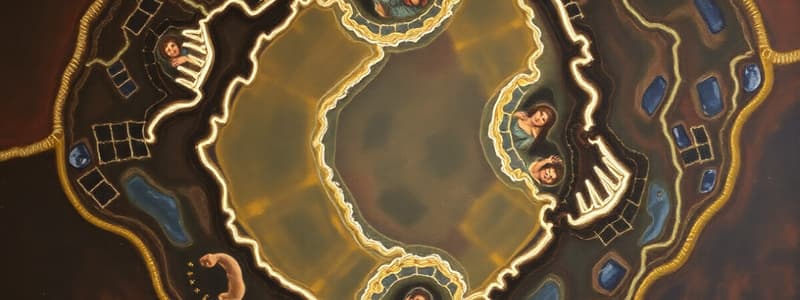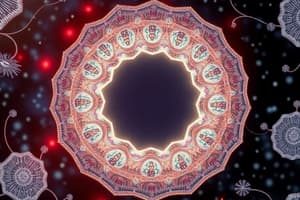Podcast
Questions and Answers
Which of the following is the correct sequence of the cell cycle?
Which of the following is the correct sequence of the cell cycle?
- G1, G2, S, M
- G2, G1, S, M
- G1, S, G2, M (correct)
- S, G1, G2, M
Mitosis results in four genetically identical daughter cells.
Mitosis results in four genetically identical daughter cells.
False (B)
The cell’s control center that contains DNA is the ______.
The cell’s control center that contains DNA is the ______.
nucleus
What is the main function of the mitochondria?
What is the main function of the mitochondria?
What is the main function of the cell membrane?
What is the main function of the cell membrane?
Match the cell organelles with their primary function:
Match the cell organelles with their primary function:
Plant cells have a cell wall made of cellulose, while animal cells do not.
Plant cells have a cell wall made of cellulose, while animal cells do not.
Which stage of the cell cycle involves DNA replication?
Which stage of the cell cycle involves DNA replication?
Which of the following is NOT a function of the cytoskeleton?
Which of the following is NOT a function of the cytoskeleton?
Robert Hooke was the first to observe living cells.
Robert Hooke was the first to observe living cells.
What are the three statements of the cell theory?
What are the three statements of the cell theory?
Organisms made up of only one cell are called ______ organisms.
Organisms made up of only one cell are called ______ organisms.
Match the following cell types with their description:
Match the following cell types with their description:
Which of the following is NOT a characteristic of prokaryotic cells?
Which of the following is NOT a characteristic of prokaryotic cells?
Mitosis is for sexual reproduction.
Mitosis is for sexual reproduction.
What happens during metaphase of mitosis?
What happens during metaphase of mitosis?
In meiosis, the exchange of genetic material between chromosomes occurs in ______.
In meiosis, the exchange of genetic material between chromosomes occurs in ______.
Which structure is found in plant cells but NOT in animal cells?
Which structure is found in plant cells but NOT in animal cells?
Animal cells have chloroplasts.
Animal cells have chloroplasts.
What is the function of the coarse adjustment knob on a compound microscope?
What is the function of the coarse adjustment knob on a compound microscope?
The lens you look through on a microscope is called the ______.
The lens you look through on a microscope is called the ______.
If a microscope has a 10x eyepiece and a 40x objective lens, what is the total magnification?
If a microscope has a 10x eyepiece and a 40x objective lens, what is the total magnification?
Match the parts of the microscope with their function:
Match the parts of the microscope with their function:
Flashcards
What is the cell cycle?
What is the cell cycle?
The process by which cells grow, prepare for division, and divide into two new cells. It ensures all cells in your body have the same information.
What happens during the G1 phase of the cell cycle?
What happens during the G1 phase of the cell cycle?
The cell grows larger, makes proteins and organelles, and prepares to copy its DNA. This happens during the first stage.
What happens during the S phase of the cell cycle?
What happens during the S phase of the cell cycle?
The cell makes a complete copy of its DNA. DNA holds the instructions for the cell's function.
What happens during the G2 phase of the cell cycle?
What happens during the G2 phase of the cell cycle?
Signup and view all the flashcards
What happens during the M phase of the cell cycle?
What happens during the M phase of the cell cycle?
Signup and view all the flashcards
What is the nucleus?
What is the nucleus?
Signup and view all the flashcards
What are mitochondria?
What are mitochondria?
Signup and view all the flashcards
What are chloroplasts?
What are chloroplasts?
Signup and view all the flashcards
Cytoskeleton
Cytoskeleton
Signup and view all the flashcards
Cell Theory
Cell Theory
Signup and view all the flashcards
Unicellular Organisms
Unicellular Organisms
Signup and view all the flashcards
Multicellular Organisms
Multicellular Organisms
Signup and view all the flashcards
Prokaryotic Cells
Prokaryotic Cells
Signup and view all the flashcards
Eukaryotic Cells
Eukaryotic Cells
Signup and view all the flashcards
Cellular Reproduction
Cellular Reproduction
Signup and view all the flashcards
Mitosis
Mitosis
Signup and view all the flashcards
Interphase
Interphase
Signup and view all the flashcards
Prophase
Prophase
Signup and view all the flashcards
Metaphase
Metaphase
Signup and view all the flashcards
Anaphase
Anaphase
Signup and view all the flashcards
Telophase
Telophase
Signup and view all the flashcards
Meiosis
Meiosis
Signup and view all the flashcards
Compound Microscope
Compound Microscope
Signup and view all the flashcards
Study Notes
Cell Cycle and Reproduction
- The cell cycle describes how cells grow, prepare for division, and become two new cells.
- This cycle ensures all cells have the same information.
- Four stages: G1, S, G2, and M.
- Errors in the cell cycle can cause uncontrolled growth (cancer).
Gap 1 (G1)
- Cell growth and protein/organelle production.
- Preparation to copy DNA.
- "Getting ready to work." phase.
Synthesis (S)
- DNA replicates.
- DNA contains instructions for cell function.
Gap 2 (G2)
- Further cell growth.
- Checks for errors in copied DNA.
- Prepares for cell division.
- Final check before cell splitting.
Mitosis (M)
- Cell divides to form two identical cells.
- Each new cell receives a full set of DNA.
Cell Structure and Organization
- Cells have organelles with specific functions.
- Nucleus: Controls cell activities; contains DNA.
- Nucleolus: Makes ribosomes.
- Cytoplasm: Suspends organelles and enables chemical reactions.
- Cell Membrane: Controls what enters/exits the cell; phospholipid bilayer with proteins and carbohydrates.
- Cell Wall (plants only): Protects & provides rigidity; made of cellulose.
- Mitochondria: Produces energy (ATP).
- Chloroplast (plants only): Converts sunlight to sugar through photosynthesis.
- Ribosomes: Make proteins.
- Endoplasmic Reticulum (ER): Transports materials.
- Rough ER: Makes proteins.
- Smooth ER: Makes lipids; detoxifies harmful substances.
- Golgi Complex: Processes and packages proteins.
- Lysosomes: Break down waste and damaged cell parts.
- Vacuole: Stores food, nutrients, and waste. Larger in plant cells.
- Cytoskeleton: Provides structure, movement, and transport.
Cell Theory
- Robert Hooke coined the term "cell" (observed cork).
- Anton van Leeuwenhoek first observed living cells ("animalcules").
- Matthias Schleiden: All plants are made of cells.
- Cell theory statements:
- All living things are composed of one or more cells.
- The cell is the basic unit of structure and function.
- All cells come from pre-existing cells.
Cellular Diversity
- Unicellular organisms: One cell; all life processes happen in one cell; small & simple; various environments (bacteria, amoeba, paramecium).
- Multicellular organisms: Many cells; cells specialized for varied tasks; work together (humans, animals, plants, fungi); larger and more complex.
Prokaryotic vs. Eukaryotic Cells
- Prokaryotic: Simple; no nucleus or membrane-bound organelles. (e.g., Bacteria, Archaea)
- DNA floats freely.
- Eukaryotic: Complex; nucleus and membrane-bound organelles; (e.g., Animal cells, plant cells, fungal cells)
- DNA is inside a nucleus.
Cellular Reproduction
-
Mitosis (Asexual): Single cell divides into two identical daughter cells; for growth, repair, and asexual reproduction. Steps: Interphase, Prophase, Metaphase, Anaphase, Telophase, Cytokinesis.
-
Meiosis (Sexual): Produces sex cells (sperm and egg); reduces chromosome number by half. Steps: Interphase, Meiosis I (Prophase I, Metaphase I, Anaphase I, Telophase I), Meiosis II (Prophase II, Metaphase II, Anaphase II, Telophase II).
Plant and Animal Cells
- Plant cells: Cell wall (cellulose); chloroplasts; larger vacuoles.
- Animal cells: No cell wall; no chloroplasts; smaller or no vacuoles; centrioles.
Compound Microscope
- Essential tool for viewing cells, bacteria, etc.
- Multiple lenses to magnify.
- Parts: Eyepiece, Objective Lenses, Stage, Stage Clips, Arm, Base, Coarse Adjustment Knob, Fine Adjustment Knob, Diaphragm, Condenser, Light Source.
- Total magnification = eyepiece magnification × objective lens magnification.
Studying That Suits You
Use AI to generate personalized quizzes and flashcards to suit your learning preferences.




